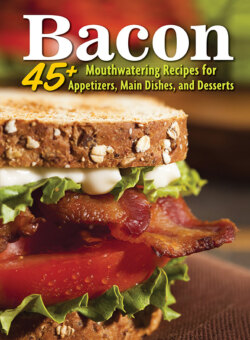Читать книгу Bacon - Группа авторов - Страница 8
На сайте Литреса книга снята с продажи.
HOGS at the THROUGH
ОглавлениеChoosing the source of your bacon is just as important as choosing the cut or flavoring.
BY LISA MUNNIKSMA
if it’s true that you are what you eat, it only makes sense that the richest-tasting bacon comes from hogs that eat the most diverse feeds. It also makes sense that pigs developed for bacon production — for the quality of their belly muscle and fat — will provide superior bacon. In today’s grocery-store-bacon society, however, some consumers have been led away from these principles.
Bacon Breeds
In general, commercial hog production favors pigs that have been selected for fast growth and lean meat. Lean meat isn’t what gives bacon its flavor; neither does fat. The best bacon flavor and texture comes from a combination of lean muscle and well-developed fat.
There are lard-pig breeds and there are “baconers,” explains Rob Levitt, co-owner of The Butcher & Larder whole-animal butcher shop in Chicago. Every bacon maker will have his or her own opinion about the best bacon breed. The Tamworth, for example, has a long body — and therefore a long belly, meaning a lot of bacon-producing potential — and is often called “the bacon pig.” At Levitt’s shop, they prefer a Berkshire-Duroc cross: “We like them because they have a nice ratio of meat to fat.”
Black Pig Meat Co. — owned by Duskie Estes and John Stewart, who also own Zazu Kitchen + Farm in Sebastopol, California — sources the majority of its bacon from Pure Country Pork, an Oregon farm that raises Chester White pigs in hoop-house systems. Depending on where on the belly the bacon is cut, Stewart gets an average of 30 percent fat in his bacon, which is ideal for him, because “I’m definitely looking to have the meat part of it expressed.”
Common breeds raised for slaughter include Yorkshire, Duroc and Tamworth.
Want to know more about butchering hogs? Turn to page.
Belly up! Most of the bacon strips seen in American stores today come from the belly of a hog, but bacon can come from the back and sides, too.
Stewart also raises Red Wattle and Mulefoot heritage-breed hogs and crosses, about 10 at a time, at his California home. He makes bacon on a small scale with these pigs. “I really like the fat on the Red Wattle,” he says. “It’s pretty close to beef fat.”
Production Systems
Pigs raised in confinement — as commercially produced pigs are in the United States — don’t have the opportunity to develop muscle fibers and flavors in the same way as pigs raised outdoors. These animals are surprisingly intelligent and social — two traits that lead to the development of negative behaviors, such as tail chewing and aggression, when pigs are kept in confinement.
“Getting them back outside as much as possible, even if it’s in a hoop barn, is better for the pig, better for the environment and better all around,” Stewart says.
When managed properly in a sustainablefarming system, pigs raised on pasture or in woodlots don’t have the concentrated manure buildup found in industrial-hog facilities; require fewer antibiotics; are not stressed from close confinement; are able to indulge in their natural “pigginess” — roaming, rooting around in the soil, wallowing in mud and foraging for foods found in nature — and can contribute to a healthy woodland ecosystem and productive multispecies grazing system, which are boons for farmers and land managers. In addition to adding to overall farm health, this exercise and the foraged foods develop the meat and enrich the flavor of the pork.
“Winter pigs taste different than summer pigs,” Levitt says. “It’s the same thing with beef and lamb.” One of the farmers who supplies The Butcher & Larder with pigs lets his animals graze in a fruit and chestnut orchard. “In November, you can really taste the fruitiness and the nuttiness,” Levitt continues. These are flavors you won’t find in commercial pork, which is most often fed a ration consisting of corn, soybean meal and minerals.
Pig to Table
Finding pasture-raised pork from different breeds isn’t as easy as going to the grocery store. There are options, though, if you’re willing to do some homework. As is the case with tomatoes (consider the taste and texture of an in-season tomato from your yard versus one shipped across the country out of season), meat tastes better when there are fewer steps between production and consumer.
“Try to start with whoever is local to you,” Stewart says. “There are going to be people who make good things, and there are going to be people who make terrible things.” Don’t buy in bulk until you know you’ll like it!
Try the local farmers market or co-op grocery store, and directly contact small-scale farmers.
“Find a source that is focused on where their animals are coming from,” Levitt says. “There are a lot of decent bacon producers out there, but if they’re just buying [confinement-raised pork] bellies, it doesn’t mean anything to me.”
If purchasing bacon sourced from local farmers isn’t an option, look to your local butcher, and learn about the sources of his meats. With a growing interest around the world in understanding food sources plus an unwavering interest in bacon, there’s always the Internet. Then you can taste-test bacon sources side by side to find the breed and the production system that suits your palate best.
Every bacon maker will have his own opinion about the best bacon breed.
Freelance writer Lisa Munniksma assists with caring for heritage-breed hogs on a farm in Kentucky. She is learning about sustainable living, agriculture and food systems around the world and writes about it at www.freelancefarmerchick.com
Less confinement leads to healthier hogs, according to educators and the U.S. Department of Agriculture.
